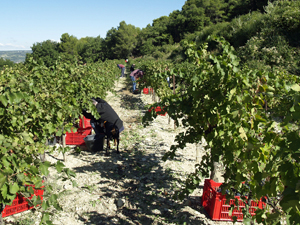
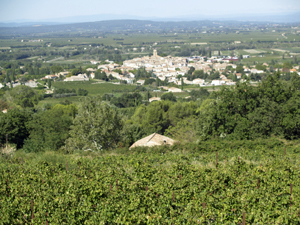
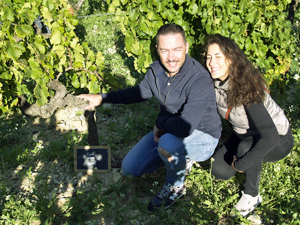
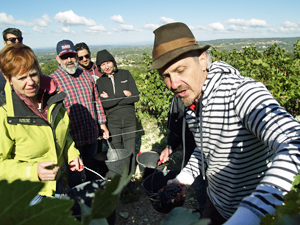
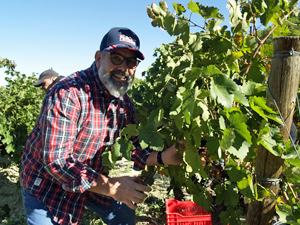
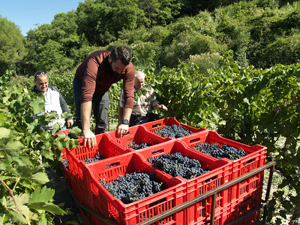
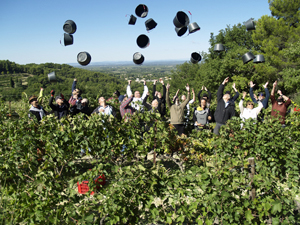
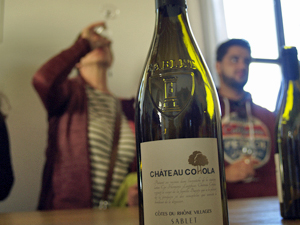
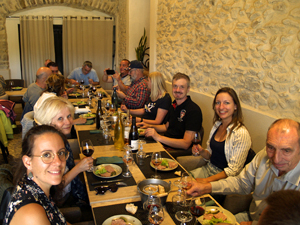
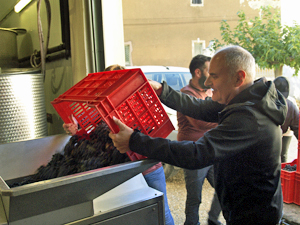
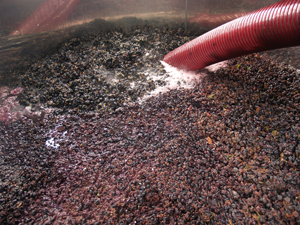
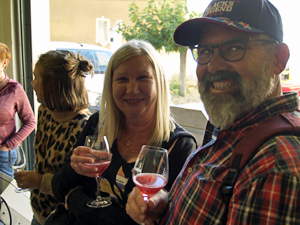
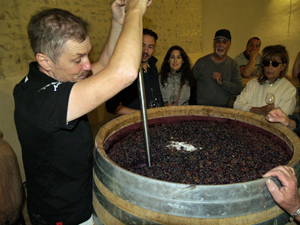













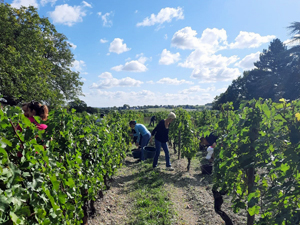
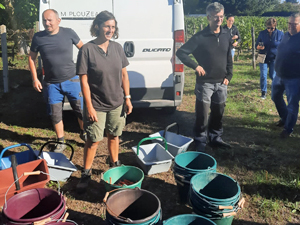
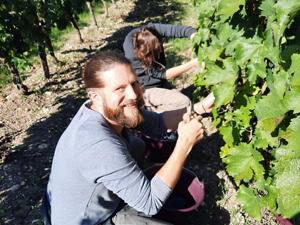
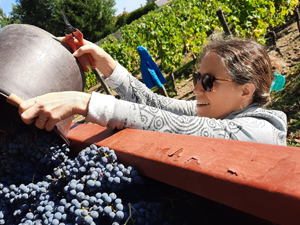
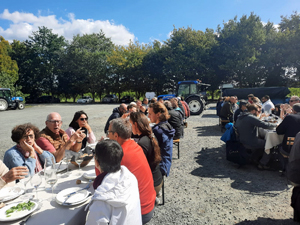
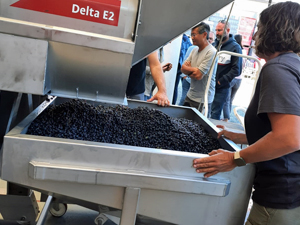
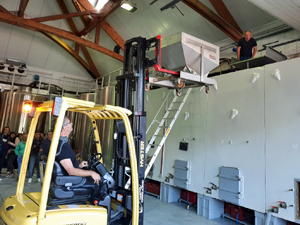
We spent another great couple of Harvest Experience Days in Saint-Emilion at Château Coutet. We were warmly welcomed by Alain and Matthieu, the father and son wine-makers at this family run winery who taught us how to harvest the grapes as we followed their journey during the course of the day from the vines and into the vats. As we were to learn, there is much more to harvesting than just picking grapes!
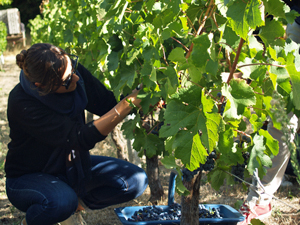
After the introductions, we headed straight out into the vineyard, climbing the hillside to reach the famed Saint-Emilion limestone plateau, where the best plots are located, including the Peycocut vineyard, home to the Gourmet Odyssey adopted vines. We took a few minutes to each find our micro-plot of vines, take a few photos and admire the lovely scenery of sloping vineyards, châteaux and the church spire of Saint-Emilion.
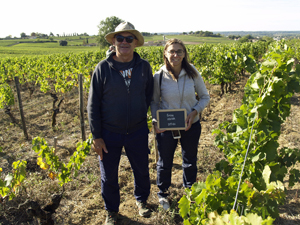
In pairs, we spread out among the rows, and started to harvest the grapes! The grapes this year were of excellent quality, so our job was made much easier. There was very little to sort, and virtually all of the grapes were for picking.
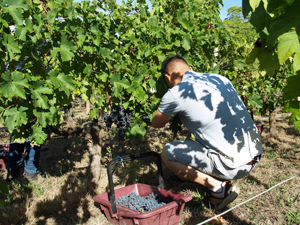
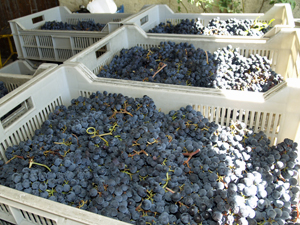
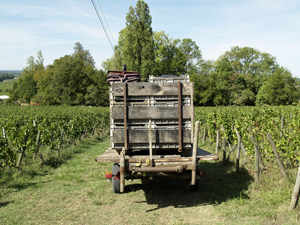
In the afternoon, our mission was to put our harvested grapes into a vat. First we had to separate the grape berries from the stems. This is normally done by a de-stemming machine, but at Château Coutet, the grapes from the best plots are done by hand, including the ones that we had picked. In fours, we gathered around some tables and removed each of the grapes by hand, placing them in a separate basket, and throwing the stems away in a bin. The stems will then be spread in the vineyards to return some nutrients to the soil. It also gave us the opportunity to remove any dried-up grapes or leaves that might have inadvertently made their way into the baskets.
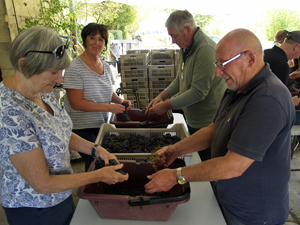
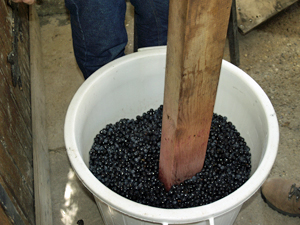
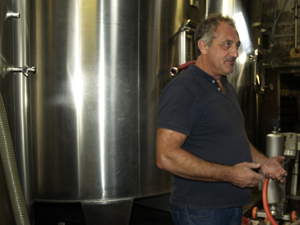
We look forward to learning more about this work, and the rest of the wine-making process to age, blend, and prepare the wine for bottling during the Vinification Experience Days next year.
We spent two great Harvest Experience Days on the 3rd and 10th September at Château de Jonquières, a magnificent family-run winery in the Terrasses du Larzac wine-growing region of Languedoc in the south of France. We were there with some clients of the Gourmet Odyssey Wine Experience who had come to get involved in harvesting the grapes and learn about how the grapes are turned into wine during the fermentation and maceration phases.
Charlotte and Clément, the young wine-making couple, are the 32nd generation of winemakers at the winery, welcomed us in the courtyard of the château over coffee. Smiles beamed from each of their faces, which maybe hid a little bit of stress that this crucial period of harvesting in the wine-making year inevitably brings!
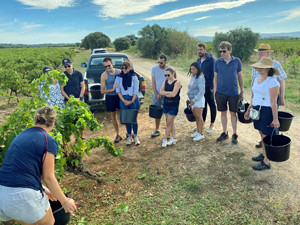
After a quick explanation of the winery’s history, the Terrasses du Larzac wine-growing region, a recap of the 2022 vintage so far, and an overview of the day’s agenda, we were equipped with a bucket and pair of secateurs. We then made our way through the vineyards to a nearby plot of Syrah vines. It’s important to pick the grapes early in the morning to preserve their full potential.
As we walked to the vines, Clément followed by tractor, pulling a trailer into which we would delicately put our harvest.
We were taught how to pick the precious grapes without damaging them or harming ourselves! Sometimes we had to remove some of the leaves in front of the bunches to be able to get to the grapes more easily.
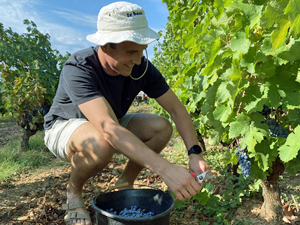
The harvest was generous and of great quality this year despite the very hot spring and summer. The vines were able to adapt to the climate and responded well to the treatment and care of the winemakers throughout the year. Some of our apprentice winemakers had learnt this first-hand during the Discovery Experience Days earlier in the year.
Once the buckets were full, we emptied them into the trailer.
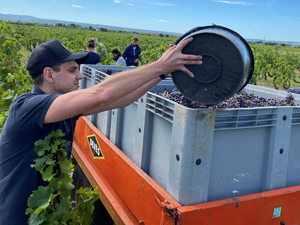
In didn’t take us long to realise that it’s a fairly difficult job. The positions we find ourselves in to pick the grapes can be uncomfortable at times, some rows are more abundant than others, and some harvesters are quicker than others... But the groups remained supportive of one another and we had lots of fun. In just over two hours, we had harvested the plot and had become real harvesters!
We had a quick refreshment break until Charlotte informed us that Clément was already ready to put out harvest into the vat.
We didn’t have any time to lose, and so we brought our precious gaped back to the winery to put them into the vat, but we had one last little job to do before then. We set about cleaning the buckets and secateurs with water so that they were nice and clean for the next day, and once again the team spirit shone through!
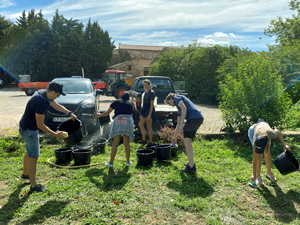
Clément carefully positioned the crates of grapes in front of the chai to then put them into the de-stemming machine.
This is in some ways the first step in making wine, and involves separating the grapes from the stems and any leaves that may have inadvertently fallen into one of the buckets. This avoids the wine from developing a bitter taste.
Once the grapes are freed from their stems, they are put into a stainless steel vat to start the fermentation process.
Charlotte then explained the differences in the process for white, red and rosé wines. For example, the red wines are kept in contact with the skins during the fermentation and maceration phase which lasts around 20 days, whereas the white grapes are immediately pressed before the fermentation phase starts to separate them from their skins.
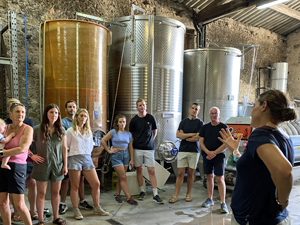
We tasted some of the grape musts that had been fermenting for 10 days, and Charlotte suggested that we put our ears to the vats to listen to the effervescence of the fermentation.
It was then time for lunch, and so we made our way back into the shade of the courtyard to taste 5 of the winery’s organic wines over lunch which had been prepared by a local caterer. We took the opportunity to ask the winemakers lots of questions about a wide range of topics such as their way of life, their philosophy of being organic, and the differences between the wine that we had tasted.
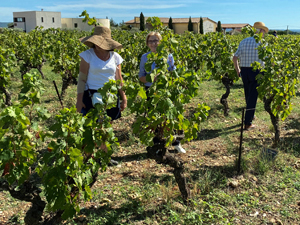
After lunch, we went to visit our adopted vines. After a short walk through the village of Jonquières, we arrived at the vineyard where our vines are located, and spent a few minutes metting our vines, and taking some photos of them.
We then returned to the chateau to bring the day to a conclusion, and collect a few bottles of wine to take home with us and share with friends and family.
We look forward to welcoming you back to the winery next year for one of the Vinification Experience Days!
After the introduction to the day by Mark, the founder of Gourmet Odyssey, and Céline, the winemaker at Domaine Stentz-Buecher, we made our way to the Steingrubler grand cru vineyard with Céline, her father, Jean-Jacques, and a few of the winery’s harvest team. Céline handed us each a pair of secateurs and a bucket, and explained which grapes to pick, and gave us some useful tips on how to avoid cutting our fingers!
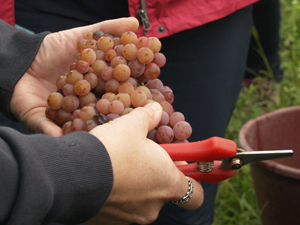
In two or fours, we were then assigned a row, and started the harvest. The grapes we were picking were of the Gewurztraminer variety, were in perfect condition, and tasted delicious! There were very few bad grapes to sort, so our buckets quickly filled up.
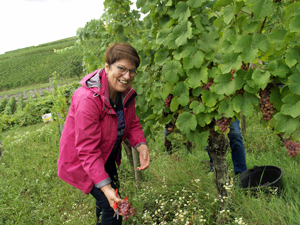
When the buckets were full, we passed them under the rows until they reached the central row of the porter. Here, we took it in turns for two people to carry a hop on their back, which we then filled up with the buckets of grapes. It’s surprising how heavy grapes can be, and when full the hopper can weigh between 40 and 50 kg.
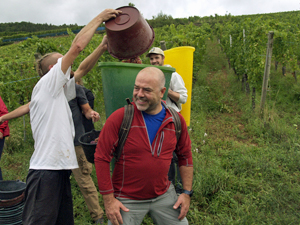
The porters then carried their load to the nearby trailer, climbed a ladder, and tipped the grapes in. You have to tip them over your shoulder, something which is a little difficult the first time, but our team of apprentice harvesters quickly got the hang of it!
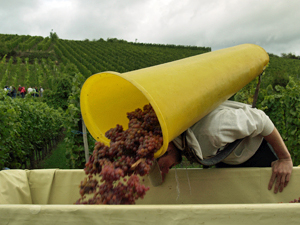
When we got to the top of the row, we then took another row and came back down. The slope made it a little harder to walk up and down, but also made it easier to pick the grapes because we could position ourselves to have the grapes higher up.
Once we had finished harvesting the plot of vines, we gathered around the trailer to admire our work, wash the sticky grape juice from our hands, and have a drink.
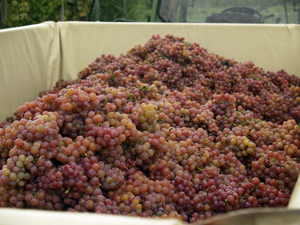
We then headed to the Rosenberg vineyard to meet our adopted vines. The grapes had been picked earlier that week because they had already reached optimum maturity. We took a few minutes to take some pictures and admire the view across the vineyards and of the nearby châteaux.
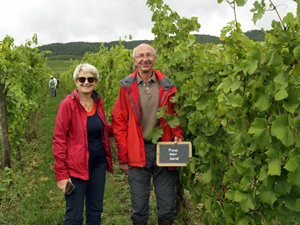
Back at the winery, we met up with Stéphane, Céline’s brother and fellow wine-maker. We helped our harvested grapes into the press by raking them out of the trailer and into the press below.
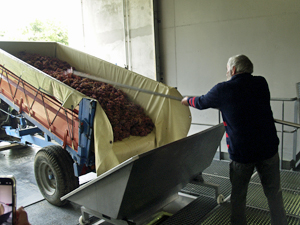
Stéphane explained how the press works, and how the cellar had been designed to use the force of gravity, as opposed to pumps, to get the juice into the vats. The first vat is a holding vat, where the juice will rest for between 24 and 48 hours during the “débourbage” process as the small solid particles of skin, pips, and stems that managed to get through the press, settle on the bottom of the vat and the juice becomes clearer.
We then headed back out into the courtyard where Céline had prepared a well earned wine tasting session for us, starting with a delicious naturally sparkling Crémant d’Alsace. For each of the following wines, we had to say what aromas and tastes we could identify, and try to guess which of the Alsace grape varietals it was. An easy task for Céline, but not quite so easy for the rest of us!
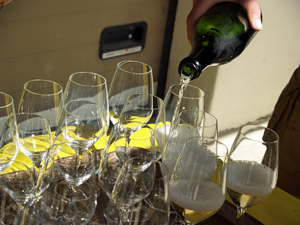
Céline first served us the 2019 Pinot Gris Rosenberg, the wine chosen for the Gourmet Odyssey Wine Experience, followed by the 2018 Sylvaner Vielles Vignes, the 2017 Riesling Steingrubler Grand Cru, and finishing with the 2019 Gewurztraminer Hengst Grand Cru.
We then continued the tasting over the harvesters lunch with the 2019 Pinot Blanc, 2020 Pinot Noir, and 2019 Gewurztraminer Rosenberg to accompany the local charcuterie, cheeses and apple pie.
After lunch, we returned to the cellar, where Stéphane showed us the fermentation hall where the white wines start the process of transforming the sugar in the grape juice into alcohol. Stéphane explained how he monitors the progress of these wines through the process, as we listened to the vats and casks gargle away.
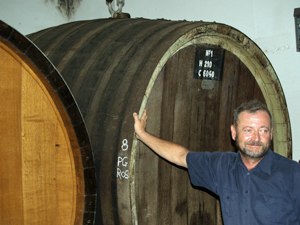
The Pinot Noir grapes don’t go into the press straight away. Stéphane explained how the berries are separated from the stems, and are then put into vats. The juice is clear in Pinot Noir grapes, the colour being found in the skin. Therefore to make red wine, the juice needs to be kept in contact with the skins to be able to extract the colour. Tannins are also found in the skin which adds body to the wine. During the fermentation phase carbon dioxide is released which pushes the skin to the surface, forming a solid cap. This cap needs to be broken and pushed down into the juice for the extraction of the colour and tannins to take place. At Domaine Stentz-Buecher this is done using the pigeage method.
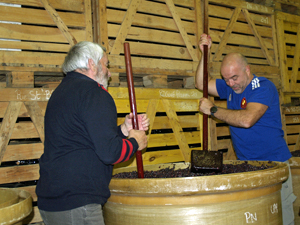
Stéphane explained pigeage and showed us how to use the large plungers to break the solid cap of skin and pips. We took it in turns to have a go, and realised that it is a very difficult job, and the cap is actually very hard to push down! The job gets easier as the fermentation progresses, but it’s still something that has to be done once or twice a day for each vat!
Before we knew it, the day had come to an end. We look forward to returning next year for the Vinification Experience Days, and learning about all of the work after the harvest to age the wines and prepare them for bottling.
Many thanks to all for making it such a great day.

The Gourmet Odyssey Wine Experience
Adopt a Vine in France and Follow the Making of Your Own Wine !
From € 169
Adopt-a-Vine Biodynamic Blending Burgundy Cellar Experience Fermentation Gift Grapes Harvest Making Organic Tasting Vine Vines Vineyard Vinification Wine Winemaker Winery